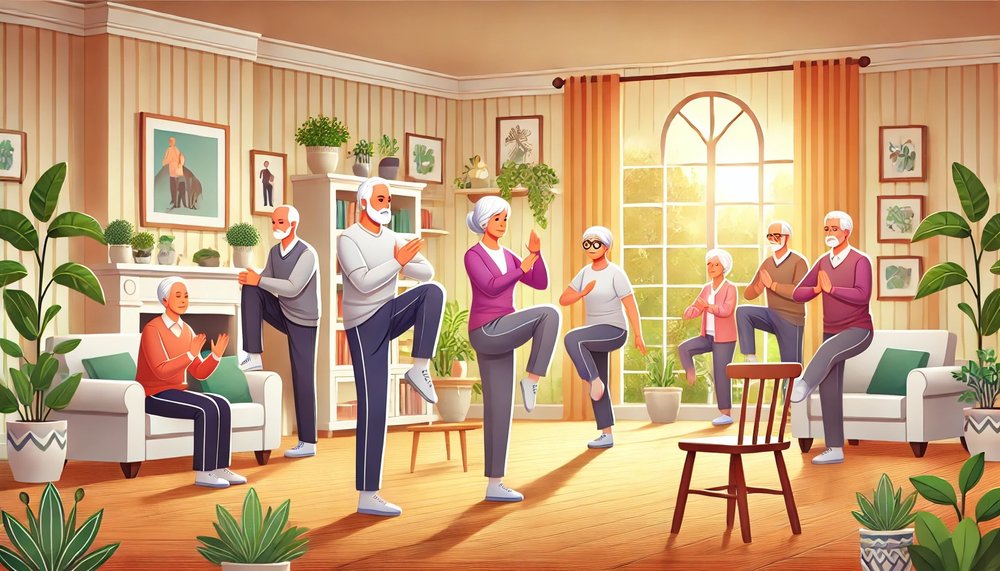
Balance is a critical aspect of daily life, especially for seniors. Maintaining good balance helps prevent falls, which are a leading cause of injury among older adults. As we age, our balance can deteriorate due to muscle weakness, joint stiffness, and changes in the vestibular system. The goal of balance exercises is to enhance stability, build strength, and boost confidence in movement. At Be On The Move, we emphasize the importance of these exercises to help seniors lead safer and more active lives.
Understanding the Need for Balance Exercises
Balance issues in seniors can arise from various factors, including:
- Muscle Weakness: Decreased muscle strength can make it difficult to maintain balance.
- Joint Stiffness: Arthritis and other conditions can limit joint mobility, affecting balance.
- Vestibular Problems: Issues with the inner ear can lead to dizziness and unsteadiness.
- Medications: Some medications have side effects that impact balance.
- Vision Changes: Reduced vision can affect spatial awareness and balance.
Goals of Balance Exercises
- Prevent Falls: Reduce the risk of falls and related injuries by improving balance and coordination.
- Enhance Stability: Enable seniors to perform daily activities with confidence and ease.
- Increase Strength: Strengthen the muscles that support balance, particularly in the legs and core.
- Boost Coordination: Improve coordination and reaction times, which are crucial for maintaining balance.
- Improve Quality of Life: Promote independence and a more active lifestyle by enhancing physical capabilities.
1. Single Leg Stance
How to Perform:
- Stand next to a sturdy chair or countertop for support.
- Lift one foot off the ground, balancing on the other leg.
- Hold the position for 10-15 seconds, then switch legs.
- Repeat 5 times on each leg.
- Start with holding onto the support and gradually reduce reliance as balance improves.
- Focus on a fixed point in front of you to help maintain balance.
How to Perform:
- Stand with your feet together.
- Step forward with one foot, placing the heel directly in front of the toes of the other foot.
- Continue walking in this heel-to-toe manner for 10-20 steps.
- Turn around and repeat in the opposite direction.
- Use a hallway or a path where you can hold onto walls if needed.
- Maintain a slow and steady pace.
How to Perform:
- Stand behind a chair, holding onto the backrest for support.
- Lift one leg out to the side, keeping it straight.
- Hold for a second and slowly lower it back down.
- Repeat 10-15 times on each leg.
- Keep your back straight and avoid leaning over.
- Engage your core muscles for added stability.
How to Perform:
- Sit in a sturdy chair with your feet flat on the floor.
- Cross your arms over your chest.
- Stand up slowly from the chair without using your hands.
- Sit back down slowly and with control.
- Repeat 10-15 times.
- If this is too difficult, start by using your hands for support and gradually reduce their use.
- Focus on engaging your leg and core muscles.
Overview:
- Tai Chi is a gentle form of exercise that involves slow, controlled movements.
- It improves balance, coordination, and flexibility.
- Weight Shifting: Stand with feet shoulder-width apart, shift weight from one foot to the other slowly.
- Arm Circles: Stand with feet shoulder-width apart, make slow circular motions with your arms.
- Attend a local Tai Chi class or follow a video guide to ensure proper technique.
- Practice in a safe, open space free from obstacles.
- Use Everyday Activities: Incorporate balance exercises into daily tasks, such as standing on one leg while brushing your teeth.
- Schedule Regular Practice: Set aside specific times each day to perform balance exercises.
- Start Slow: Begin with easier exercises and gradually progress to more challenging ones.
- Stay Consistent: Regular practice is key to improving balance and stability.
- Seek Guidance: Consult with a physical therapist from Be On The Move for personalized advice and modifications.
Maintaining good balance is essential for preventing falls and promoting independence in seniors. By incorporating these balance exercises into their daily routine, seniors can experience significant improvements in stability, strength, and confidence. At Be On The Move, we are dedicated to providing the best home health physical therapy services to help our clients lead healthier, more active lives. Start these exercises today and take the first step towards better balance and a safer lifestyle!
At Be On The Move, we are committed to supporting older adults at every stage of their health journey, ensuring they have the resources and care they need to thrive. Let’s plant the seeds of health together, fostering growth and resilience during life’s golden years.
See you soon,//❤️ Trudy//
The information provided in this article is intended for general educational and informational purposes only. It is not a substitute for professional medical advice, diagnosis, or treatment. Always seek the advice of your physician or other qualified health provider with any questions you may have regarding a medical condition or before starting any new exercise program. If you experience any pain or difficulty with exercises or advice mentioned in this article, stop immediately and consult your healthcare provider. Be On The Move and its representatives do not assume any responsibility for any aspect of healthcare administered with the aid of information provided herein. The content is not intended to cover all possible uses, directions, precautions, or adverse effects. If you have concerns or believe that the content may contain errors or inaccuracies, contact us at beonthemove.com so we can address the issue.



